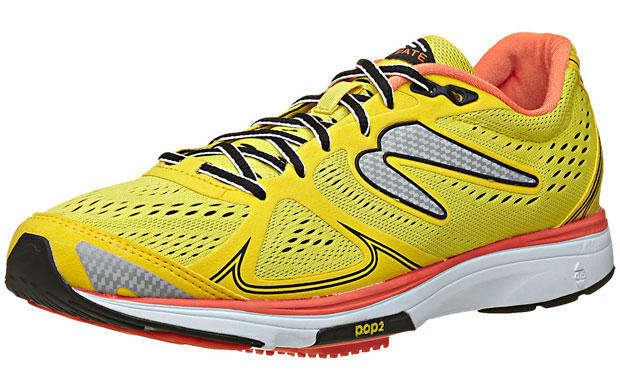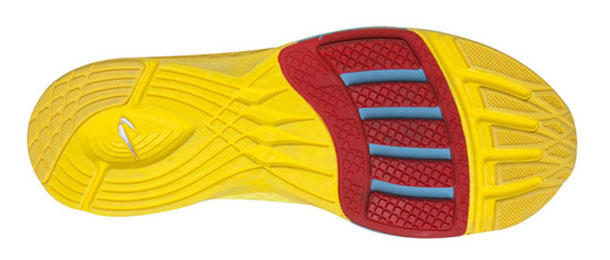Newton Distance Elite
The Newton Distance Elite is the latest shoe in the Newton range built on the "old" 4-lug platform. Why? I'm not really sure, but I don't mind at all. Although I like the new 5-lug models, I still frequently run in 4 lugs. (When Newton replaced the 4 lugs with the 5-lug models, I ordered several extra pairs of 4 lugs as a precaution.) The feel is different, but they both appeal to me. The 5-lug platform provides a wider base and thus more stability, but I never lacked for stability in the older models.
The Newton Distance Elite was built over a year ago for the Newton Elite Running Team. The team requested a shoe that was as light as possible – lighter than the other Distance models – but with a little more drop than the MV2, which was built as a zero drop shoe.

To build the shoe, the people at Newton began with the platform of the latest 4-lug Distance model and then started taking away material to make the shoe lighter, and they were fearless. The upper is almost completely stripped to just a single layer of large gauge mesh. There are only 3 points on the upper that have some form of reinforcement: the toe section, the mid foot section, and a small heel cup. This makes the upper flexible and light but also eliminates most of the support. When running fast in a sharp curve, my feet press against the upper at the side of the shoe. This lack of support becomes even more pronounced when running on anything other than smooth asphalt. But to be fair, this shoe was built for runners with a neutral gait and concerned only with speed.
Newton advertises this shoe as equipped with an asymmetrical lacing system. The asymmetry is minimal, and only noticeable where the laces start and the tongue attaches to the shoe. This is in contrast to asymmetrical lacing designs used by other brands, where the laces are placed to the side of the foot.
The tongue attaches to the inside of the shoes with two elastic bands on each side of the foot. The intended function of these bands is uncertain – maybe to stop the tongue from sliding to one side? This is easy to fix with the laces alone. I had a problem with sticking my toes in behind the bands when transitioning from bike to run. I cut them out and solved the problem, and I had no resulting issues with the tongue sliding to one side.

The midsole is the traditional 4-lug sole with the POP 1 lug system. However when I compare this sole to unused, older 4-lug Distance models, the lugs seem to be less aggressive or less prominent than on the older models. Possibly Newton took some material away from the midsole or lugs to make the shoe lighter, but the drop is exactly the same as older Distance models. At 2 mm it feels a bit thinner than the older 4-lug Distance models, but this sensation could be caused by the reduced weight of the shoe and my increased awareness of the ground. Maybe Newton can shed some light on this and let readers know if there is an actual difference in sole thickness.
Long time Newton-sponsored professional triathletes Craig Alexander and Rachel Joyce appear to favor the Distance Elite, but others like 7th place Kona 2014 finisher Tim van Berkel continue to run in the 5-lug Distance model. Even among the pros it seems to be largely a matter of personal preference.

If you are in strong shape and run with an efficient gait, the Distance Elite can be a great triathlon shoe. You will want to equip your pair with a faster lacing system, but on the plus side the upper is so open that the shoe doesn't hold water or spilled liquids. However if you require even modest support or cushioning, I advise you to pick one of the other models in the Newton range. The Distance Elite is a great, light shoe and available in an Ironman branded model, but it is probably only ideal for runners and triathletes who can get away with the bare minimum of support and cushioning.
The Newton Distance Elite (or Ironman Elite) weighs in at 7.2 ounces for men's size 9. The Elite model comes in two colors, the Ironman Elite in just one.






Start the discussion at forum.slowtwitch.com